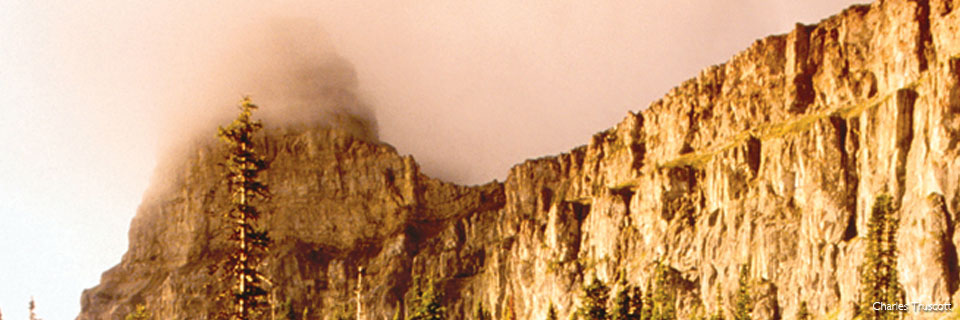
17 government inspectors, 170 companies and more than 9,000 potential infractions: inside B.C.’s oversight of the oil and gas sector
Notes made by regulator officers during thousands of inspections that were marked in compliance with...
A world heritage site in Newfoundland is under extreme threat from fracking, according to a recent report by the Canadian Parks and Wilderness Society (CPAWS). The report, entitled “One Step Forward / Two Steps Back” says Gros Morne Park, along with several other nationally and provincially protected areas, is in danger from “inappropriate development.”
Recently, a proposal by Shoal Point Energy Limited and several other companies to search for oil in the rock layers just metres from the park's border captured the attention of The United Nations Education, Scientific and Cultural Organization (UNESCO). During its June meeting in Phnom Penh, Cambodia UNESCO delegates drafted a resolution to ask for further environmental review from the Canadian government.
UNESCO declared Gros Morne Park a world heritage site in 1987 because it offers a unique glimpse into the tectonic processes that formed the east coast through continental drift. The coveted designation marks the park for protection alongside the world’s most important natural and cultural landmarks.
Robert Cadigan, president and CEO of the Newfoundland and Labrador Oil and Gas Industries Association, tried to quell fears in an interview with MacLean’s Magazine by pointing to the industry’s safety record. “There have been tens of thousands of wells fracked in Western Canada, just as an example — successfully — with no environmental damage.”
But the CPAWS report points out that development would greatly increase traffic on the park’s one road as well as lead to possible ground water contamination. It may also endanger the area’s well-developed tourism industry.
“For 30 years people have worked really hard to build a sustainable tourism industry around Gros Morne, based on Gros Morne. And this proposal would put that existing economy at risk,” pointed out CPAWS representative Alison Woodley.
Other dangers to the Canadian park system mentioned in the CPAWS report include the Yukon territorial government’s scrapping of its Peel Watershed Planning commission.
A major sub-basin of the Mackenzie River, the Peel Watershed is a largely pristine wilderness with massive biodiversity. There is currently a moratorium on development while consultations with First Nations groups continue, but there are already 8431 active mineral claims in the area, 6773 of which were staked after the planning process began.
After seven years of study, First Nations groups and the territorial government recommended 80% of the watershed be protected. Shortly thereafter, the plan was scrapped entirely. In February, Green Party leader Elizabeth May wrote an open letter to the Yukon government urging them to take the commission’s advice.
Ontario too backed away from its 2010 commitment to increase the protected area in Algonquin Park from 22% to 49%.
On the federal scale, budget cutbacks of $30 million per year have lead to a 30% reduction in ecosystem scientist positions and put some major ecological restoration programs on hold.
The report from CPAWS also called out Manitoba for continuing to allow mining and logging in protected areas. Although Manitoba agreed to ban peat mining in February of this year, the province is still in the process of approving a copper mine in Grass River Provincial Park.
The Hudbay copper mine will be situated by Reed Lake, a crucial travel corridor for endangered woodland caribou.
In terms of future recommendations, the report suggests strengthening regulations against oil and gas exploration in Nova Scotia’s Sable Island National Park. The area was designated a national park in June.
"Yesterday, oil and gas companies could drill on Sable Island and today with royal assent they won’t be able to," said Halifax MP and NDP environment critic Megan Leslie.
The Green Party objected to the designation, saying stronger protections are needed to stop oil and gas exploration in the area.
The CPAWS report points out that southern Alberta’s Castle wilderness area, which has been endangered by logging, oil and gas exploration, may become a Wildland and 
The region features spectacular rock formations and supplies drinking and agricultural water for 70 communities. Alberta Environment and Sustainable Resource Development will have a land use report on the area available in August.
Canada’s national and provincial parks provide not only spectacular views for tourists but also preserve wildlife diversity and assure a clean water supply for much of the country. CPAWS collaborates with indigenous people, local communities, governments and industry to ensure that this continues to be true. Their goal is to protect half of Canada’s public land and water.
Image Credit: VisitGrosMorne via Flickr
Image Credit: peelwatershed via Flickr
Image Credit: Charles Truscott via CPAWS
Get the inside scoop on The Narwhal’s environment and climate reporting by signing up for our free newsletter. On March 17, federal Conservative Leader Pierre Poilievre...
Continue reading
Notes made by regulator officers during thousands of inspections that were marked in compliance with...

Racing against time, dwindling habitat and warming waters, scientists are trying to give this little-known...

From investigative reporting to stunning photography, we’ve been recognized with four 2024 CAJ Awards nods...
